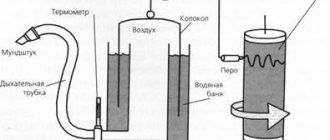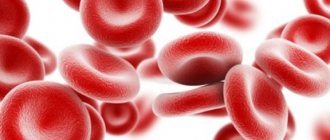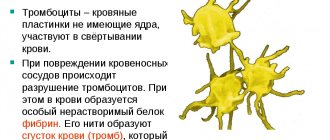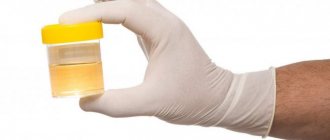Table of contents
- Erythrocytes (red blood cells)
- Leukocytes (white blood cells)
- Platelets (blood platelets)
Blood consists of 60% plasma. This is a yellowish-white liquid, which in turn consists mainly of water, as well as various proteins, salts, trace elements and vitamins. About 40% of blood consists of cells [cell], which are called blood corpuscles or blood cells. There are three types of blood cells, which are found in different numbers and perform different tasks:
- red blood cells (erythrocytes)
- white blood cells (leukocytes)
- blood platelets (platelets)
Erythrocytes (red blood cells)
Most of the human blood contains red blood cells, which are also called red blood cells or red blood cells. They make up 99% of all blood cells. In one microliter of blood (that is, in one millionth of a liter) there are from 4 to 6 million red blood cells.
The most important task of red blood cells is to carry vital oxygen through the blood vessels (which enters the lungs) to the organs and tissues of the body. They perform this task with the help of the red blood pigment - hemoglobin.
If the number of red blood cells in the blood is not enough, or if there is little hemoglobin in the red blood cells and therefore they cannot fully perform their work, then we are talking about anemia, or anemia. “Anemic” people often have very pale skin. Since their body does not receive enough oxygen, they also experience symptoms such as fatigue, weakness, shortness of breath, decreased performance, headache or back pain.
The main thing in assessing the work of red blood cells is, first of all, not their number in the blood, but their volume, the so-called hematocrit (abbreviated in Ht tests), and the level of hemoglobin (abbreviated in Hb tests). For children older than infancy, the normal level of hemoglobin is considered to be between 10 and 16 g/dl, and the normal hematocrit range is between 30 and 49% (see table for details) [KUL2002].
If these indicators are significantly lower than normal and at the same time the child develops symptoms of anemia [anemia], for example, due to leukemia, or after chemotherapy [chemotherapy], then a transfusion (transfusion) of red blood cell concentrate (packed red blood cells, abbreviated as “ermass”) may be required ) to stabilize the child's condition.
| Child's age | Hemoglobin (Hb) level in g/dl | Hematocrit (Hk) indicator in % |
| 1 year | 10.1 — 13.0 | 30 — 38 |
| 26 years | 11.0 — 13.8 | 32 — 40 |
| 6 – 12 years | 11.1 — 14.7 | 32 — 43 |
| 12 – 18 years old women | 12.1 — 15.1 | 35 — 44 |
| 12 – 18 years old men | 12.1 — 16.6 | 35 — 49 |
Platelets
Platelets are the smallest blood cells. Their diameter is 0.003 mm, they are nuclear-free. The number of platelets in 1 mm3 of blood is in the range of 200–400 thousand.
Formed in red bone marrow. They live for about 8 days. They are destroyed in the spleen. The main function of platelets is associated with their participation in blood clotting.
Platelets
Blood clotting usually occurs during bleeding from blood vessels as a result of the interaction of special proteins, enzymes and other substances that make up the so-called blood coagulation system.
This system includes fibrinogen protein dissolved in the blood plasma, the enzyme prothrombin, calcium ions, the enzyme thromboplastin contained in platelets and many other components. Platelet prothrombin and thromboplastin are inactive enzymes, so blood clotting does not occur under normal blood flow conditions.
The process of blood coagulation during vascular injury is very complex and in the final stage comes down to the fact that fibrinogen in the blood plasma is converted into an insoluble protein, fibrin, which has a fibrous structure.
As a result of this, a blood clot is formed, consisting of fibrin threads, between which are the formed elements of blood. In a schematic presentation of the blood coagulation process, three phases can be distinguished:
1) formation of active blood (or complete) thromboplastin. It is formed as a result of the interaction of platelet thromboplastin and other substances contained in blood platelets with certain proteins (various globulins) and other components of blood plasma.
This interaction occurs during bleeding, during which blood platelets are destroyed from contact with the edges of the wound and from them various substances involved in blood clotting enter the plasma. Tissue thromboplastin, which is released into the blood plasma from tissues when they are wounded, also participates in blood clotting.
2) under the influence of active thromboplastin in the presence of calcium ions, inactive prothrombin in the blood plasma is converted into the active enzyme thrombin.
3) under the influence of active thrombin, fibrinogen is converted into fibrin - a blood clot is formed.
Vitamin K is important for blood clotting.
With its participation in the liver, the enzyme prothrombin is synthesized, which flows from the liver into the blood. In the blood circulating in the body, along with the coagulation system, there is also an anticoagulation system. It includes heparin, a substance that prevents blood clotting (such substances are called anticoagulants), fibrinolysin, an enzyme that under certain conditions dissolves fibrin if it has formed in the vessels, and other components.
Both systems - coagulation and anticoagulation are interconnected and their action is balanced under normal conditions.
Blood is the most important liquid tissue of the human body. It contains a special sugar called glucose in dissolved form. It is glucose that provides the cells of the entire body with the “fuel” they need, and not only with it, but also with oxygen, as well as numerous nutritional components. In addition, it is blood that helps remove unnecessary waste from cells.
With its help, the human body can fight infectious pathologies, as well as restore damaged blood cells. Approximately seven to eight percent of the human body weight consists of blood. In case of bleeding, the body can survive ten percent of the lost blood, but if the blood loss is thirty percent, then it is already dangerous. If a person loses fifty percent of his blood, then he can be considered already dead.
Blood consists of forty-five percent red blood cells, platelets and white blood cells, and fifty-five percent plasma.
As for plasma itself, it is a liquid with a light yellow color that contains both proteins and water, enzymes, glucose, salts, hormones, carbohydrates, lipids, and so on.
Plasma is necessary, first of all, in order to transport those same leukocytes, platelets and red blood cells. But we will talk about them in more detail.
Let's start with platelets
, under which are hidden the blood platelets necessary for the blood clotting process.
In addition, they nourish the endothelium of blood vessels. There should be about two hundred to three hundred thousand of them in one cubic millimeter of blood.
The size of each platelet reaches about three microns. It turns out that the total number of these red plates in human blood is approximately one thousand two hundred and fifty billion. If it were possible to arrange the platelets in one row, the distance would be two thousand five hundred kilometers.
Regarding red blood cells
, then they are red blood cells, the main function of which is considered to be both the absorption of oxygen in the lungs and its transfer to all organs and tissues of the human body.
They also transport carbon dioxide into the lungs. About two to three million of these bodies die every second, but the same number are produced every second. They live for about four months. There are about twenty-five million red blood cells in one cubic millimeter of blood. Their total number is twenty-five billion. In just one drop of blood there are about two hundred and fifty million red blood cells.
If we talk about leukocytes
, then they mean white blood cells, which have a protective function.
In one cubic milliliter of blood there are from five to nine thousand leukocytes. The average size of white blood cells is fifteen microns.
Their total number in the human body reaches thirty-five billion. If you arrange the leukocytes in one row, you can get a distance of five hundred twenty-five kilometers. Before use, you should consult a specialist.
Leukocytes (white blood cells)
White blood cells or white blood cells, also called leukocytes, together with platelets in healthy people, make up only 1% of all blood cells. A level of 5,000 to 8,000 leukocytes per microliter of blood is considered normal.
Leukocytes are responsible for the body's immune defense. They recognize “foreigners”, such as bacteria, viruses or fungi, and neutralize them. If there is an infection, the white blood cell count can increase greatly in a short time. Thanks to this, the body quickly begins to fight pathogens.
White blood cells are divided into different groups depending on their appearance, where they grow, and exactly how they work. The largest group (60 to 70%) consists of so-called granulocytes; from 20 to 30% are lymphocytes and from 2 to 6% are monocytes (“eater cells”).
These three types of cells fight pathogens in different ways, while simultaneously complementing each other's work. Only due to the fact that they work in harmony, the body is provided with optimal protection against infections. If the number of white blood cells decreases or they cannot work normally, for example in leukemia, then the body's defense against “foreigners” (bacteria, viruses, fungi) can no longer be effective. Then the body begins to pick up various infections.
The total white blood cell count is measured in a blood test [blood test]. The characteristics of different types of white blood cells and their percentage can be examined in a so-called differential blood test (leukocyte formula).
Granulocytes
Granulocytes are primarily responsible for protecting the body from bacteria [bacteria]. They also protect against viruses, fungi and parasites (for example, worms). And they are called that because their cellular fluid contains grains (granules). In the place where the infection appears, they instantly accumulate in large quantities and become the “first echelon” that repels the attack of pathogens.
Granulocytes are so-called phagocytes. They capture an enemy that has entered the body and digest it (phagocytosis). In the same way, they cleanse the body of dead cells. In addition, granulocytes are responsible for working with allergic and inflammatory reactions, and with the formation of pus.
The level of granulocytes in the blood is very important in the treatment of cancer. If during treatment their number becomes less than 500 - 1,000 in 1 microliter of blood, then, as a rule, the danger of infectious infections increases greatly, even from pathogens that are usually not dangerous at all for a healthy person.
Lymphocytes
Lymphocytes are white blood cells, 70% of which are found in the tissues of the lymphatic system. Such tissues include, for example, the lymph nodes, spleen, pharyngeal tonsils (tonsils) and thymus gland.
Groups of lymph nodes are located under the jaws, in the armpits, on the back of the head, in the groin area and in the lower abdomen. The spleen is an organ that is located on the left side of the upper abdomen under the ribs; The thymus gland is a small organ behind the breastbone. In addition, lymphocytes are found in lymph. Lymph is a colorless, watery fluid found in lymphatic vessels. It, like blood, covers the entire body with its branches.
Lymphocytes play a major protective role in the immune system, as they are able to specifically recognize and destroy pathogens. For example, they play an important role in viral infection. Lymphocytes “organize” the work of granulocytes, producing so-called antibodies in the body. Antibodies are small protein molecules that attach to pathogens and thus mark them as “enemies” to phagocytes.
Lymphocytes recognize and destroy body cells affected by the virus, as well as cancer cells, and remember those pathogens with which they have already been in contact. Experts distinguish between T-lymphocytes and B-lymphocytes, which differ in their immunological characteristics, and also identify some other, rarer subgroups of lymphocytes.
Monocytes
Monocytes are blood cells that go into tissues and there begin to work as “large phagocytes” (macrophages), absorbing pathogens, foreign bodies and dead cells, and clearing them from the body. In addition, they present part of the absorbed and digested organisms on their surface and thus activate lymphocytes for immune defense.
Table of normal values and deviations from the norm
This table shows particle standards and possible deviations.
Important information: What are platelets in a blood test (the norm and what they are responsible for)
| № | Indicators | Normal for a woman | Normal for a man | Increased rate | Reduced rate |
| 1 | Red blood cells | 3.7-4.7 x 1 µl | 4-5.1 x 1 µl | Erythrocytosis. Reasons: dehydration, heart disease, lack of oxygen in the mountains. | Erythropenia. Causes: anemia, blood loss. |
| 2 | Platelets | 180-320 x 1 µl | 180-320 x 1 µl | Thrombocytosis. Cause: blockage of blood vessels. | Thrombocytopenia. Reason: increased bleeding. |
| 3 | Leukocytes | 4-9 x 1 µl | 4-9 x 1 µl | Leukocytosis. Causes: leukemia, heart attack, blood loss. | Leukopenia. Cause: viral infection. |
The number of red blood cells, leukocytes and platelets are interrelated. Despite the fact that the functions of each cell are different, each of them, individually and in interaction, pursues one goal - to ensure human life and protect the body.
Platelets (blood platelets)
Blood platelets, also called platelets, are primarily responsible for stopping bleeding. If damage occurs to the walls of blood vessels, they clog the damaged area in the shortest possible time and thus stop the bleeding.
Too low a platelet level (occurs, for example, in patients with leukemia) manifests itself in nosebleeds or bleeding gums, as well as small hemorrhages on the skin. Even after the most minor injury, bruises may appear, as well as hemorrhages in the internal organs.
The platelet count in the blood may also drop due to chemotherapy. Thanks to transfusion (transfusion) of blood platelets (platelet concentrate), as a rule, it is possible to maintain an acceptable level of platelets.











